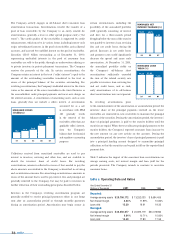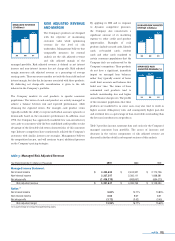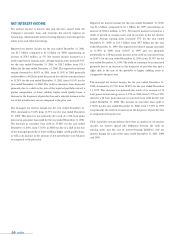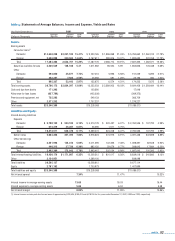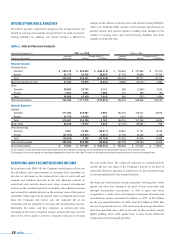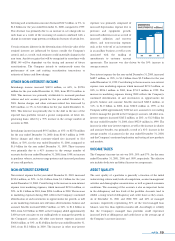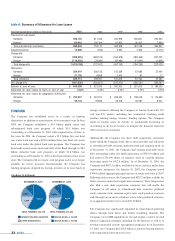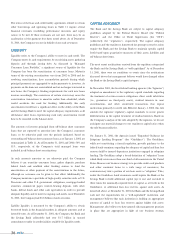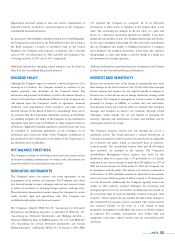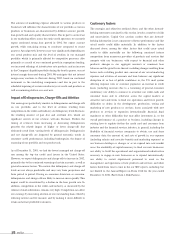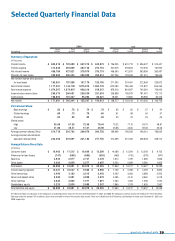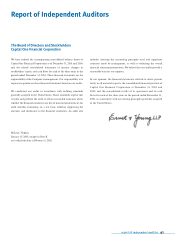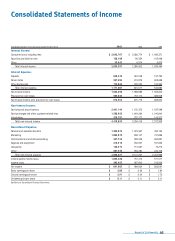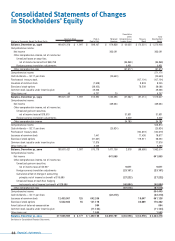Capital One 2001 Annual Report Download - page 36
Download and view the complete annual report
Please find page 36 of the 2001 Capital One annual report below. You can navigate through the pages in the report by either clicking on the pages listed below, or by using the keyword search tool below to find specific information within the annual report.
CAPITAL ADEQUACY
The Bank and the Savings Bank are subject to capital adequacy
guidelines adopted by the Federal Reserve Board (the “Federal
Reserve”) and the Office of Thrift Supervision (the “OTS”)
(collectively, the “regulators”), respectively. The capital adequacy
guidelines and the regulatory framework for prompt corrective action
require the Bank and the Savings Bank to maintain specific capital
levels based upon quantitative measures of their assets, liabilities and
off-balance sheet items.
The most recent notifications received from the regulators categorized
the Bank and the Savings Bank as “well-capitalized.” As of December
31, 2001, there were no conditions or events since the notifications
discussed above that management believes would have changed either
the Bank or the Savings Bank’s capital category.
In November 2001, the four federal banking agencies (the “Agencies”)
adopted an amendment to the regulatory capital standards regarding
the treatment of certain recourse obligations, direct credit substitutes
(i.e., guarantees on third-party assets), residual interests in asset
securitizations, and other securitized transactions that expose
institutions primarily to credit risk. Effective January 1, 2002, this rule
amends the Agencies’ regulatory capital standards to create greater
differentiation in the capital treatment of residual interests. Based on
the Company’s analysis of the rule adopted by the Agencies, we do not
anticipate any material changes to our regulatory capital ratios when
the rule becomes effective.
On January 31, 2001, the Agencies issued “Expanded Guidance for
Subprime Lending Programs” (the “Guidelines”). The Guidelines,
while not constituting a formal regulation, provide guidance to the
federal bank examiners regarding the adequacy of capital and loan loss
reserves held by insured depository institutions engaged in subprime
lending. The Guidelines adopt a broad definition of “subprime” loans
which likely covers more than one-third of all consumers in the United
States. Because our business strategy is to provide credit card products
and other consumer loans to a wide range of consumers, the
examiners may view a portion of our loan assets as “subprime.” Thus,
under the Guidelines, bank examiners could require the Bank or the
Savings Bank to hold additional capital (up to one and one-half to
three times the minimally required level of capital, as set forth in the
Guidelines), or additional loan loss reserves, against such assets. As
described above, at December 31, 2001 the Bank and the Savings Bank
each met the requirements for a “well-capitalized” institution, and
management believes that each institution is holding an appropriate
amount of capital or loan loss reserves against higher risk assets.
Management also believes we have general risk management practices
in place that are appropriate in light of our business strategy.
34 md&a
The terms of the lease and credit facility agreements related to certain
other borrowings and operating leases in Table 11 require several
financial covenants (including performance measures and equity
ratios) to be met. If these covenants are not met, there may be an
acceleration of the payment due dates noted above. As of December
31, 2001, the Company was not in default of any such covenants.
LIQUIDITY
Liquidity refers to the Company’s ability to meet its cash needs. The
Company meets its cash requirements by securitizing assets, gathering
deposits and through issuing debt. As discussed in “Managed
Consumer Loan Portfolio,” a significant source of liquidity for the
Company has been the securitization of consumer loans. Maturity
terms of the existing securitizations vary from 2002 to 2008 and for
revolving securitizations, have accumulation periods during which
principal payments are aggregated to make payments to investors. As
payments on the loans are accumulated and are no longer reinvested in
new loans, the Company’s funding requirements for such new loans
increase accordingly. The occurrence of certain events may cause the
securitization transactions to amortize earlier than scheduled, which
would accelerate the need for funding. Additionally, this early
amortization would have a significant effect on the ability of the Bank
and the Savings Bank to meet the capital adequacy requirements as all
off-balance sheet loans experiencing such early amortization would
have to be recorded on the balance sheet.
The amounts of investor principal from off-balance sheet consumer
loans that are expected to amortize into the Company’s consumer
loans, or be otherwise paid over the periods indicated, based on
outstanding off-balance sheet consumer loans as of January 1, 2002 are
summarized in Table 11. As of December 31, 2001 and 2000, 54% and
51%, respectively, of the Company’s total managed loans were
included in off-balance sheet securitizations.
As such amounts amortize or are otherwise paid, the Company
believes it can securitize consumer loans, gather deposits, purchase
federal funds and establish other funding sources to fund the
amortization or other payment of the securitizations in the future,
although no assurance can be given to that effect. Additionally, the
Company maintains a portfolio of high-quality securities such as U.S.
Treasuries and other U.S. government obligations, mortgage-backed
securities, commercial paper, interest-bearing deposits with other
banks, federal funds and other cash equivalents in order to provide
adequate liquidity and to meet its ongoing cash needs. As of December
31, 2001, the Company had $3.8 billion of such securities.
Liability liquidity is measured by the Company’s ability to obtain
borrowed funds in the financial markets in adequate amounts and at
favorable rates. As of December 31, 2001, the Company, the Bank and
the Savings Bank collectively had over $1.7 billion in unused
commitments under its credit facilities available for liquidity needs.


